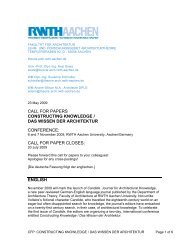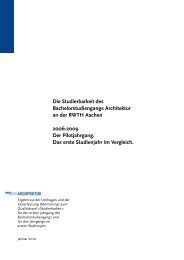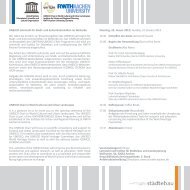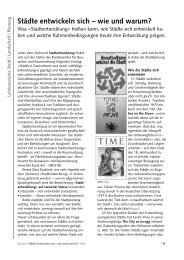Gutachten Dresden_englisch_dritte f.indd - Fakultät für Architektur ...
Gutachten Dresden_englisch_dritte f.indd - Fakultät für Architektur ...
Gutachten Dresden_englisch_dritte f.indd - Fakultät für Architektur ...
You also want an ePaper? Increase the reach of your titles
YUMPU automatically turns print PDFs into web optimized ePapers that Google loves.
The Old Carola Bridge<br />
The Old Carola Bridge, designed by H. Klette with the assistance of W. Köpcke, was<br />
built between 1892 and 1895. The Old Carola Bridge – like the Marien Railway Bridge<br />
– consists of a massive shore section with a steel structure spanning the Elbe on massive<br />
pylons. It too was configured with the small above-pylon viewing platforms that are<br />
characteristic of <strong>Dresden</strong> city bridges. The Old Carola Bridge was so severely damaged<br />
during WW II that it could not be reconstructed. It had an overall length of 332 metres.<br />
The New Carola Bridge<br />
In 1965, because of changing traffic conditions, competitive proposals were invited for<br />
the reconstruction of the Carola Bridge. It was stipulated that the Altstadt current pylon<br />
was to be removed in order to improve traffic flow on the Elbe. In addition, tram car<br />
and auto traffic had to be separated from each other through the use of safety barriers.<br />
A design proposed by engineers Thürmer and Spoelgen called for a structure composed<br />
of three pre-stressed concrete box girders that are narrower towards the centre and at<br />
full height over the bridge pylons. The middle girder overarching the Elbe has a span<br />
width of 120 metres. The bridge has an overall length of 396 metres. The width of the<br />
bridge is 35 metres.<br />
The “Blue Wonder“ Loschwitz Bridge<br />
The Loschwitz Bridge, designed by Köpke and Krüger, was built between 1891 and<br />
1893. Preliminary planning dates back to 1872 when the Loschwitz and Blasewitz<br />
authorities required a better link for traffic between the two villages. The bridge has<br />
a cantilever beam running over three partitions that is flexibly positioned between<br />
two massive end trestles. The Loschwitz Bridge was one of the first bridge designs<br />
in Europe without pylons and was an engineering sensation at the time. When put<br />
into service, the bridge was 11 metres in width, seven metres of which comprise road<br />
surface and rail tracks. The two 2-metre wide walkways were initially accommodated<br />
inside the bridge. Later, in 1935, the width of the bridge was enlarged to 13,60 metres<br />
by re-locating the walkways to the outside. The Loschwitz Bridge has an overall length<br />
of 296 metres. The two access ramps on either side of the bridge have a length of 165<br />
metres and 115 metres. Both of the access ramps are provided for the most part with<br />
supporting walls.<br />
Bridges outside the UNESCO World Heritage Site “<strong>Dresden</strong> Elbe Valley“<br />
Kaditz Bridge/Flügelweg Bridge<br />
Kaditz Bridge marks the western boundary of the UNESCO World Heritage Site<br />
“<strong>Dresden</strong> Elbe Valley“. The bridge came into existence in 1929/30, crossing the river<br />
79

















